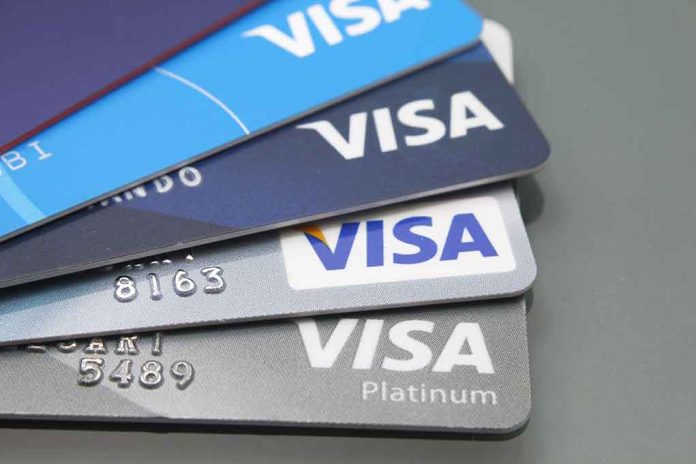
Millions of Americans struggle with credit card debt, but with the right strategies, you can break free from dependency and regain control of your financial future.
At a Glance
- Creating a detailed budget that maps income against essential and non-essential expenses is the first step toward breaking credit card dependency
- Using cash for discretionary spending helps avoid the “invisible money” syndrome that leads to overspending with credit cards
- The “snowball method” (paying smallest balances first) and “high-rate method” (tackling highest interest rates first) are proven debt reduction strategies
- Building an emergency fund prevents reliance on credit cards for unexpected expenses
- Implementing a 24-hour waiting period for non-essential purchases can significantly reduce impulse spending
Understanding the Credit Card Trap
Credit cards offer convenience and rewards that make them appealing financial tools. However, their ease of use can quickly lead to mounting debt and high interest rates that compound over time. Many cardholders fall into patterns of spending beyond their means, making only minimum payments, and eventually finding themselves trapped in a cycle of debt that seems impossible to escape. The key to breaking free begins with understanding exactly how credit cards work – including interest rates, grace periods, and how minimum payments mostly cover interest rather than reducing principal balances.
The psychology behind credit card spending contributes significantly to dependency issues. When you swipe a card or enter numbers online, your brain doesn’t register the transaction in the same way it does when you hand over physical cash. This “invisible money” effect makes overspending much easier and more common. Recognizing this psychological disconnect is crucial for developing healthier financial habits and breaking the cycle of credit card dependency.
Creating an Effective Budget Framework
The foundation of financial freedom starts with a comprehensive budget that accurately reflects both your income and expenses. Begin by tracking all spending for a full month to understand where your money actually goes – many people are surprised to discover how much they spend in certain categories. Once you have this data, categorize expenses as essential (housing, utilities, groceries, transportation) and non-essential (dining out, entertainment, subscription services). This clear delineation helps prioritize where your money should go first.
“The best way to get rid of credit card debt is to develop a plan and stick to it.” Bank of America
When building your budget, allocate funds toward debt reduction as a non-negotiable expense category. Many financial experts recommend the 50/30/20 rule – spending 50% of income on needs, 30% on wants, and 20% on savings and debt repayment. However, if you’re serious about breaking credit card dependency, consider temporarily adjusting this ratio to dedicate more toward debt elimination. Modern budgeting apps can automate much of this process, providing visual representations of spending patterns and progress toward financial goals.
Proven Debt Reduction Strategies
When tackling existing credit card debt, two primary methods have proven effective. The “snowball method” involves paying minimum amounts on all cards while directing extra funds toward the smallest balance first. Once that’s paid off, the amount you were paying goes toward the next smallest balance, creating momentum that can be psychologically motivating. Alternatively, the “high-rate method” focuses on paying off the card with the highest interest rate first, which saves more money over time but may not provide the same quick wins as the snowball approach.
“When you pay more than the monthly minimum, you’ll pay less in interest overall.” Bank of America
For those with multiple high-interest cards, debt consolidation offers another path forward. Options include balance transfer cards with promotional 0% interest periods, personal loans with lower fixed rates, or home equity lines of credit. Each has advantages and potential drawbacks, so research carefully before proceeding. If you’re struggling to make even minimum payments, don’t hesitate to contact your credit card companies directly. Many offer hardship programs that can temporarily reduce interest rates or adjust payment schedules during financial difficulties.
Building New Financial Habits
Breaking free from credit card dependency requires developing new habits that support financial health. Consider implementing a 24-hour rule for non-essential purchases over a certain amount – this cooling-off period often reduces impulse buying significantly. For spending categories where you tend to overspend, switch to using cash exclusively. The physical act of handing over money creates more awareness and naturally limits spending to what you have on hand. Research shows that people typically spend 12-18% less when using cash instead of credit cards for the same purchases.
Perhaps most importantly, build an emergency fund to cover unexpected expenses without reaching for credit cards. Start with a goal of $1,000, then work toward saving 3-6 months of essential expenses. This financial buffer prevents minor emergencies from derailing your progress and creates peace of mind that reinforces your commitment to avoiding unnecessary debt. Remember that breaking credit card dependency is a marathon, not a sprint – celebrate small victories along the way and be patient with yourself through setbacks.







